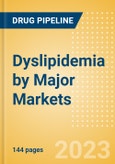Examples of key findings from this report include the following:
- 2022 base year sales within the dyslipidemia market are approximately $5.6 billion across the 7MM detailed in this report. The publisher estimates that this market will grow at a compound annual growth rate (CAGR) of 10.8% to reach $15.5 billion by the end of the forecast period
- The growth of the PCSK9 class, among others in the dyslipidemia pipeline, highlights the current expansion of biologics into the dyslipidemia market. However, due to their high prices, there is a significant disconnect between patients who are eligible for treatment based on regulatory approval and those who receive treatment. In response to this, there is ample opportunity for more cost-effective therapies targeting the more general dyslipidemia market. This is where pipeline drugs such as Merck's first oral PCSK9 inhibitor, MK-0616, will address this unmet need
Key Highlights
According to the publisher, the drug sales in the dyslipidemia market are expected to grow significantly between 2022 and 2032, with an overall compound annual growth rate (CAGR) of 10.8%. In 2022, the publisher estimated the total dyslipidemia market to be valued at $5.56 billion across the 7MM. In 2022, the US made up the majority of total global sales, with $4.12 billion (74%). The 5EU accounted for 21% of the global dyslipidemia market sales with an estimated value of $1.18 billion million and Japan's dyslipidemia market sales were estimated to be $252.9 million in 2022, accounting for 5% of the market.By the end of the forecast period in 2032, the publisher expects the dyslipidemia market to grow at a CAGR of 10.8%, reaching sales of $15.53 billion, with the US accounting for 78% of the global market with a market value of $12.06 billion. This could be due to the large prevalence of dyslipidemia in the US, as well as the higher overall price of drugs as compared to the 5EU and Japan. Moreover, the US has more pipeline drugs entering the dyslipidemia market during the forecast period compared to the 5EU and Japan. The 5EU is anticipated to grow with a CAGR of 8.3%, reaching sales of $2.63 billion. Japan accounts for 5% of the total sales with a CAGR of 12.8% by the end of the forecast period.
Major drivers of the dyslipidemia market growth during the forecast period are:
- The increasing global prevalence of dyslipidemia due to an increase in obesity, sedentary lifestyles, and unhealthy dietary habits. As the global population continues to age, the prevalence of dyslipidemia is likely to increase
- Improved awareness about the health risks associated with dyslipidemia and increased efforts in screening and diagnosis are expected to lead to more people being diagnosed with the condition
- Therapies with new targets will enter the market, which will significantly boost market growth
- The launch of the first oral PCSK9 inhibitor, Merck's MK-0616, as well as other promising pipeline therapies, including NewAmsterdam's oral CETP inhibitor, obicetrapib, and Akcea Therapeutics's apoC-III, olezarsen
Major barriers that will restrict the growth of the dyslipidemia market during the forecast period are:
- The price of novel launched drugs for dyslipidemia and the restriction of access to highly priced new therapies
- Widespread use of cheap, generic drugs making it difficult for high-priced branded therapies to penetrate the market
- Continued generic erosion of Pfizer's Lipitor, AstraZeneca's Crestor (rosuvastatin), as well as Merck's Zetia (ezetimibe) across the 7MM
Scope
- Overview of dyslipidemia, including epidemiology, symptoms, diagnosis, and disease management
- Annualized dyslipidemia therapeutics market revenue, cost of therapy per patient, and treatment usage patterns forecast from 2022 to 2032
- Key topics covered include strategic competitor assessment, market characterization, unmet needs, clinical trial mapping, and implications of these factors for the dyslipidemia therapeutics market
- Pipeline analysis: comprehensive data assessing emerging trends and mechanisms of action under development for dyslipidemia treatment. The most promising candidates in late-stage development are profiled
- Analysis of the current and future market competition in the global dyslipidemia therapeutics market. Insightful review of the key industry drivers, restraints and challenges. Each trend is independently researched to provide qualitative analysis of its implications
Reasons to Buy
- Develop and design your in-licensing and out-licensing strategies through a review of pipeline products and technologies, and by identifying the companies with the most robust pipeline
- Develop business strategies by understanding the trends shaping and driving the 7MM dyslipidemia therapeutics market
- Drive revenues by understanding the key trends, innovative products and technologies, market segments, and companies likely to impact the 7MM dyslipidemia therapeutics market in the future
- Formulate effective sales and marketing strategies by understanding the competitive landscape and by analyzing the performance of various competitors
- Identify emerging players with potentially strong product portfolios and create effective counter-strategies to gain a competitive advantage
- Organize your sales and marketing efforts by identifying the market categories and segments that present maximum opportunities for consolidations, investments and strategic partnerships.
Table of Contents
Companies Mentioned (Partial List)
A selection of companies mentioned in this report includes, but is not limited to:
- NewAmsterdam Pharma
- Dicerna
- BASF
- Arrowhead
- Akcea
- Novartis
- Pfizer
- Sanofi/Regeneron
- Amgen
- Amryt
- Abbott
- Amarin
- Esperion Therapeutics
- Eli Lilly
- Novo Nordisk








